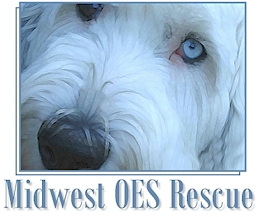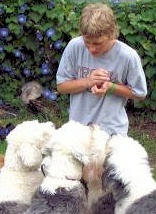|
 |
POSITIVE
REINFORCEMENT TRAINING
We all like to be
praised rather than punished. The same is true for your dog, and
that's the theory behind positive reinforcement. Positive
reinforcement means giving your pet something pleasant or rewarding
immediately after she does something you want her to do. Because
your praise or reward makes her more likely to repeat that behavior
in the future, it is one of your most powerful tools for shaping or
changing your dog's behavior.

Correct timing is essential when using positive reinforcement. The
reward must occur immediately—within seconds—or your pet may not
associate it with the proper action. For example, if you have your
dog "sit" but reward her after she's already stood back up, she'll
think she's being rewarded for standing up.
Consistency is also essential. Everyone in the family should use the
same commands. It might help to post these where everyone can become
familiar with them.
The most commonly
used commands for dogs are:
-
"watch me"
-
"sit"
-
"stay"
-
"down" (which means "lie
down")
-
"off" (which means "get off
of me" or "get off the furniture")
-
"stand"
-
"come"
-
"heel" or "let's go"
-
"leave it"
-
"settle"
|
|

At Midwest Old
English Sheepdog Rescue...
we strongly encourage
adopters to enroll their new family member in a Positive
Reinforcement Obedience Training Class. It will not only help you
and your dog understand one another better -- but it will build the
bond between you and your family member stronger and sooner. There's
nothing better than working with and understanding your best friend.
|

'bobtails in foster
care' |
|
|
 |
Using Positive
Reinforcement
For your pet, positive
reinforcement may include food treats, praise, petting, or a
favorite toy or game. Food treats work especially well for training
your dog. A treat should be enticing and irresistible to your pet.
It should be a very small, soft piece of food, so that she will
immediately gulp it down and look to you for more. If you give her
something she has to chew or that breaks into bits and falls on the
floor, she'll be looking around the floor, not at you. Small pieces
of soft commercial treats, hot dogs, cheese, or cooked chicken or
beef have all proven successful. Experiment a bit to see what works
best for your pet. You can carry the treats in a pocket or fanny
pack. Each time you use a food reward, you should couple it with a
verbal reward (praise). Say something like, "Good dog," in a
positive, happy tone of voice.
Some pets may not be interested in food treats. For those pets, the
reward could be in the form of a toy or brief play.
When your pet is learning a new behavior, she should be rewarded
every time she does the behavior, which means continuous
reinforcement. It may be necessary to use a technique called
"shaping" with your pet, which means reinforcing something close to
the desired response and then gradually requiring more from your dog
before she gets the treat. For example, if you're teaching your dog
to "shake hands," you may initially reward her for lifting her paw
off the ground, then for lifting it higher, then for touching your
hand, then for letting you hold her paw, and finally, for actually
"shaking hands" with you.
Intermittent reinforcement can be used once your pet has reliably
learned the behavior. At first, reward her with the treat three out
of every four times she does the behavior. Then, over time, reward
her about half the time, then about a third of the time, and so on,
until you're only rewarding her occasionally with the treat.
Continue to praise her every time—although once your dog has learned
the behavior, your praise can be less effusive, such as a quiet, but
positive, "Good dog." Use a variable schedule of reinforcement so
that she doesn't catch on that she only has to respond every other
time. Your pet will soon learn that if she keeps responding,
eventually she'll get what she wants—your praise and an occasional
treat.
By understanding reinforcement, you'll see that you're not forever
bound to carry a pocketful of goodies. Your dog will soon be working
for your verbal praise, because she really does want to please you
and knows that, occasionally, she'll get a treat, too. There are
many small opportunities to reinforce her behavior. You may have her
"sit" before letting her out the door (which helps prevent
door-darting), before petting her (which helps prevent jumping up on
people), or before feeding her. Give her a pat or a "Good dog" for
lying quietly by your feet, or slip a treat into a Kong®-type toy
when she's chewing it instead of your shoe.
|
|
 |
The Pros and Cons of Punishment
Punishment can be
verbal, postural, or physical, and it means giving your pet
something unpleasant immediately after she does something you don't
want her to do. The punishment makes it less likely that the
behavior will occur again. To be effective, punishment must be
delivered while your pet is engaged in the undesirable behavior—in
other words, "caught in the act." If the punishment is delivered too
late, even seconds later, your pet will not associate the punishment
with the undesired behavior.
Punishment delivered by you may erode your dog's trust. That's why
punishment is most effective when it does not come directly from
you. For example, after your dog acts in an undesirable way, use a
shake can, an air horn, or keys—but don't draw attention to the fact
that the noise comes from you. If your dog perceives her
"environment," instead of you, to be delivering the punishment,
she'll be more likely to avoid the behavior even when you're not
around.
In addition, if you're too late in administering it, punishment will
seem totally unpredictable to your dog. She's likely to become
fearful, distrustful, and/or aggressive, which will only lead to
more behavior problems.
What we humans often interpret as "guilty" looks are actually
submissive postures by our pets. Animals don't have a moral sense of
right and wrong, but they are adept at associating your presence,
and the presence of a mess, with punishment. If you've tried
punishment and it hasn't worked, you should definitely stop using
punishment and use only positive reinforcement instead.
And never use physical punishment that involves some level of
discomfort or even pain, which may cause your pet to bite to defend
herself. Holding the neck skin and shaking your dog, or performing
"alpha rolls" (forcing your dog onto her back and pinning her on the
floor), are both likely to result in bites.
Also, punishment might be associated with other stimuli, including
people, that are present at the time the punishment occurs. For
example, a pet who is punished for getting too close to a small
child may become fearful of, or aggressive to, that child—or to
other children. That's why physical punishment is not only bad for
your pet, it's also bad for you and others.
©2002. Adapted from material originally developed by applied animal
behaviorists at the Dumb Friends League, Denver, Colorado. All
rights reserved.
'annie with her mum and angel,
susan and their fabulous trainer'
|
|
 |

Midwest Old English Sheepdog Rescue
"Volunteers Dedicated to OES and Other Orphaned Canines"
|